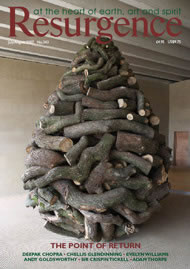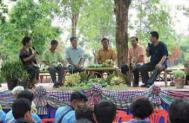ALTHOUGH MANY resource-conserving practices are now being used across the world’s agricultural systems, the total number of farmers using them is still relatively small. This is because the adoption of such practices is not a costless process. Transition costs arise for several reasons. Farmers must first invest in learning. As recent policies have tended to promote specialised systems with a lower innovation capacity, so farmers have to spend time learning about a greater diversity of practices. Lack of information and management skills is, therefore, a barrier to the adoption of sustainable agriculture. During transitions, farmers have to experiment more, and so incur the costs of making mistakes as well as of acquiring new knowledge. The biological processes that make sustainable agriculture productive also take time to become established.
Modern farmers have come to depend on a great variety of agricultural chemicals to control pests, weeds and diseases. Each year, some 2.5 billion kilos of pesticides are applied to farms worldwide, with global annual sales in the early 21st century amounting to $US25 billion, down from the US$30 billion heights of the late 1990s. Now, though, many farmers are finding alternative methods for pest, disease and weed control. Though integrated pest management dates back to the 1950s, a significant paradigm shift occurred in the mid-1980s when Peter Kenmore and his colleagues found that pest attack on rice was directly proportional to the amount of pesticides used. In other words, more pesticides meant more pests.
The reason was simple. Pesticides were killing the predators: natural antidotes of insect pests, such as spiders and beetles. When these are eliminated from rice fields, then pest numbers increase rapidly. This led to the launch of ‘field schools’ to help farmers learn about the benefits of biodiversity in agriculture. The outcomes in terms of human and social development have been remarkable, and farmer field schools are now being deployed in many parts of the world: by 2005, more than four million farmers had been trained in 175,000 field schools in seventy-eight countries. The largest numbers are in Indonesia (1.1 million), Vietnam (930,000), Bangladesh (650,000), the Philippines (500,000), India (255,000), Egypt (210,000), China (130,000), Thailand (75,000), Nepal (57,000), Kenya (46,000) and Sri Lanka (45,000).
Many countries are now reporting large reductions in pesticide use, and in no case has reduced pesticide use led to lower yields. The key to this success is biological diversity on farms. Pests and diseases like monocultures, as there is an abundance of food and no balance of natural enemies. Traditionally, rice paddies were important sources of protein, and fish living in fields helped in nutrient cycling and pest control. But most pesticides are toxic to fish, and their increased use from the 1960s eliminated beneficial fish from many paddies. Take the pesticides away, though, and the fish can be reintroduced.
In Bangladesh, more than 31,000 farmer field schools have trained farmers in more sustainable rice production methods. Rice yields do not rise by much, but costs of production fall owing to reduced pesticide use. Each hectare of paddy, though, yields up to 750 kg of fish, a substantial increase in productivity for very poor farmers. One farmer said to Tim Robertson, former leader of the programme, “Our fields are singing again, after thirty years of silence.” It is the frogs that are singing in diverse fields full of fish and rice. Arif Rashid of CARE (Cooperative for Assistance and Relief Everywhere) says farmers have crossed a frontier: “We were able to change the behaviour of farmers with regard to use of fertilisers and insecticides, and they now have an improved understanding of eco-
logy. They now take decisions based on careful study of their own farms.”
IN CONTRAST TO these government-supported efforts, the north-east of Thailand has seen something quite different, where the organisation of more than 100,000 farmers into new networks has occurred precisely because the chemical-based modern agricultural approach failed abjectly. The north-east of Thailand has always seen itself as a little different from the rest of the country, with its Khymer influence to the east and Laotian to the north. It is a region of dry, sandy soils, with erratic rainfall. When the Asian economic collapse of the late 1990s occurred, many families found themselves saddled with debt for agricultural inputs. In addition, the income sent by family members working in distant urban areas dried up, leaving rural families with no obvious place to turn. Sawaeng Ruaysoongnern, of Khon Kaen University, who has worked closely with these farmers’ networks, says, “This extreme failure caused people to think differently.”
The first reaction from farmers was to step back from monocultures and begin to recreate polycultures. They diversified with vegetables, herbs, animals, fruits and multipurpose trees, and started to organise into groups. These soon connected into networks across the region. They developed an active recruitment system: each farmer aims to recruit two more each year, and each group of ten farmers seeks to establish another group annually. The consequences have been remarkable. Farmers have become more self-
sufficient, growing more of their own food, but also earning more from better links to consumers in local and regional markets. The aim is to have a million members – perhaps this is too ambitious, but then again, big thoughts are needed if whole regional landscapes and communities are to change for the better.
There is a great diversity in these local wisdom networks, as they are called. The Organic Rice Network in Yasothon, led by Vichit Buonsoong, has 2,000 core members and more than 20,000 network members. All these farmers no longer use inorganic fertilisers and pesticides. Another network with 760 members focuses on agroforestry – though they translate this to mean more than just trees. “Agroforestry”, explains Ruaysoongnern, “is not about planting trees on agricultural land, but the development of new relationships between humans and natural systems.” In a drier area, another network of 170 farmers in twenty villages is working to establish trees so as to reduce water tables and reclaim saline seeps that are threatening crops. And yet another is focusing on intensive polycultures, with the aim of producing enough food for an entire family from one rai of land (a sixth of a hectare) – the ‘one rai per family’ concept.
These networks use modern information technology to share knowledge, ideas and innovations where they can. They have created video profiles of individual farmers and have put them on CDs to distribute across the region. These tell a story to consumers and policy-makers, too. These farmers’ networks are beginning to influence local and national policies; many farmers themselves say happiness is the most important thing for them. Their model for development, therefore, is different and again instructive. Why make all this effort if you cannot be happy?








